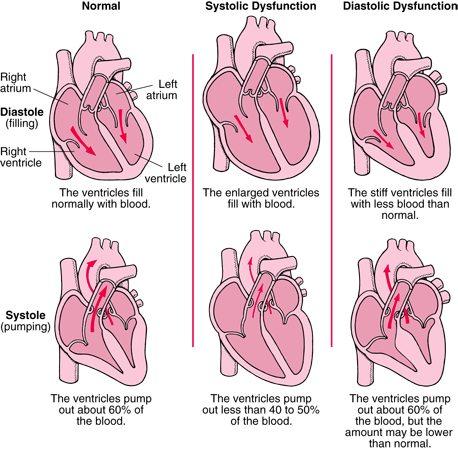The most common cause of heart failure is indeed coronary artery disease (CAD), but there are many other causes for heart failure.
Heart Function
The function of the heart is to pump. A pump moves fluid out of one place and into another. For example, the right side of the heart pumps blood from the veins into the lungs. The left side of the heart pumps blood from the lungs out through the arteries to the rest of the body. Blood goes out when the heart muscle contracts (called systole) and comes in when the heart muscle relaxes (called diastole).
Heart functioning capacity, termed EF for ejection fraction has a normal range of 55 to 65%. An EF< 50% is decreased, and < 30% is generally considered severe.
Heart Failure
Heart failure develops when the pumping action of the heart is inadequate, typically because the heart muscle is weaker, stiffer, or both. As a result, blood may not flow out in adequate amounts. Blood may also build up in the tissues from which it is coming, causing congestion in those tissues.
Accumulation of blood coming into the left side of the heart causes congestion in the lungs, making breathing difficult. This is called congestive heart failure.
Accumulation of blood coming into the right side of the heart causes congestion and fluid accumulation in other parts of the body, such as the legs and the liver.
In heart failure, your heart may not pump enough blood to meet the body’s need for oxygen and nutrients, which are supplied by the blood. As a result, arm and leg muscles may tire more quickly, and the kidneys may not function normally.
Heart failure has two main forms: systolic dysfunction and diastolic dysfunction. Some people with heart failure have both.
Normally, the heart stretches as it fills with blood (during diastole), then contracts to pump out the blood (during systole). The main pumping chambers in the heart are the ventricles.
The heart chambers always contain some blood, but different amounts of blood may enter or leave the chambers with each heartbeat as indicated by the thickness of the arrows.
In systolic dysfunction, the heart contracts less forcefully and cannot pump out as much of the blood that is returned to it as it normally does. As a result, more blood remains in the lower chambers of the heart (ventricles). Blood then accumulates in the lungs, veins, or both.
In diastolic dysfunction, the heart is stiff and does not relax normally after contracting, which impairs its ability to fill with blood. The heart contracts normally, so it is able to pump a normal proportion of blood out of the ventricles. Sometimes the stiff heart compensates for its poor filling by pumping out an even higher proportion of the blood than it normally does. However, eventually, as in systolic dysfunction, the blood returning to the heart accumulates in the lungs or veins. Often, both forms of heart failure occur together.
Hope this helps,
Dr T,
http://www.cardiac-risk-assessment.com/
(From: The Merck Manuals, Heart failure, by J. Malcolm O. Arnold, MD)


Comments 2
I have got my 2D coliur Doppler echo cardiographic report in which it is mentioned”mild septal hyopertrophy” in the report Inter vent.septam thickness ED 13
In my ECG it is mentioned Normal Ecg (Except T Waves I in aVL
As per blood report Total cholesterol 250mg and LDL 151mg
Presently I have continous chest pain and pain in left hend
Please suggest what is wrong and what i have to do.
Thnx
Your ECHO and EKG have no serious abnormalities, but your cholesterol/LDL are bad and need treatment. Your chest pain may well be caused by coronary artery blockages; these other tests don’t give any information about that. You need a stress test and a cardiologist to check you out,
Dr T
http://www.cardiac-risk-assessment.com/